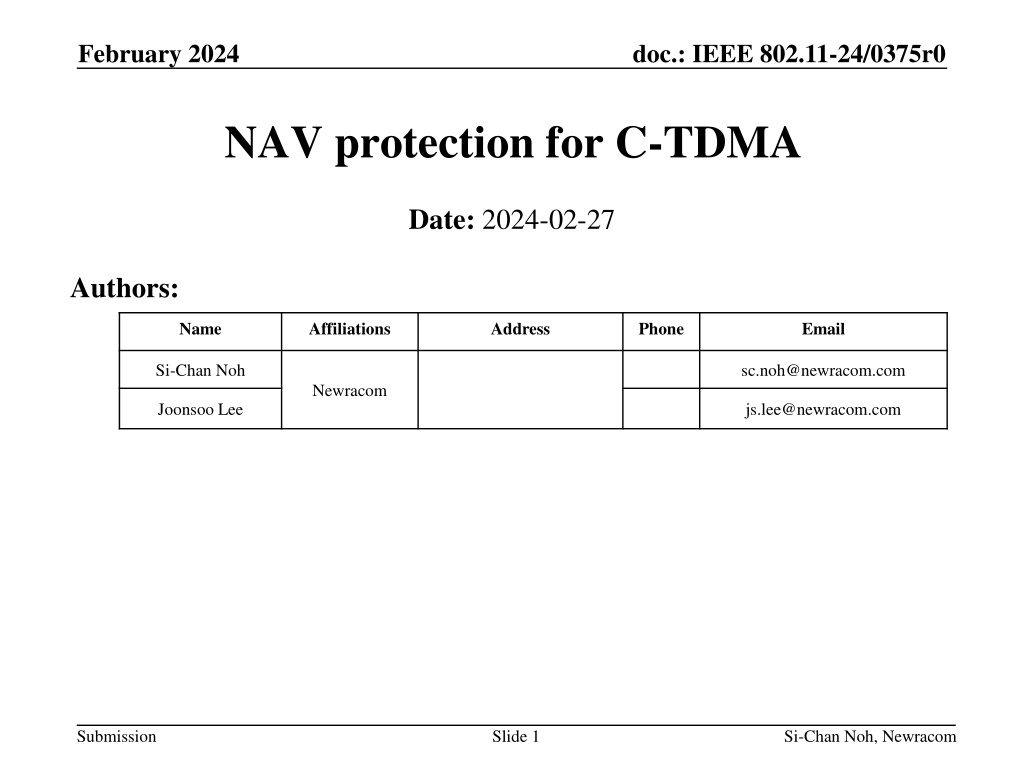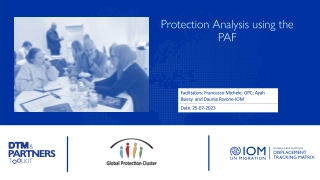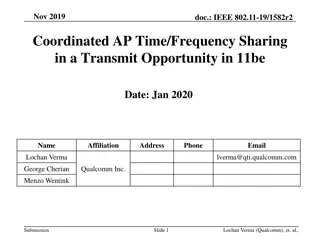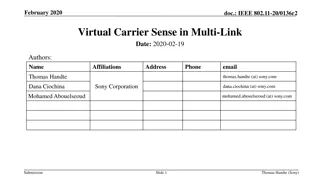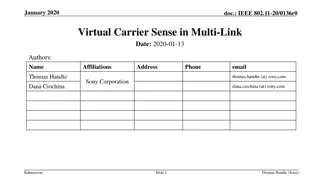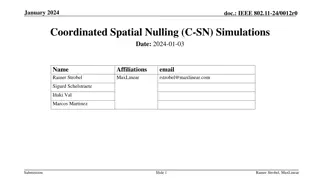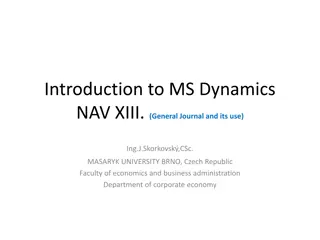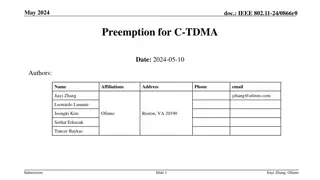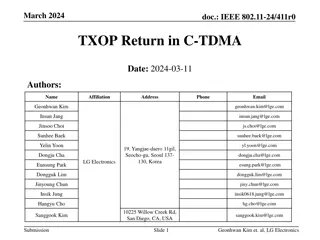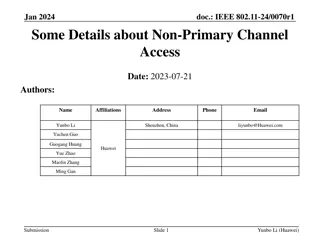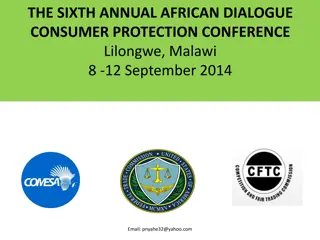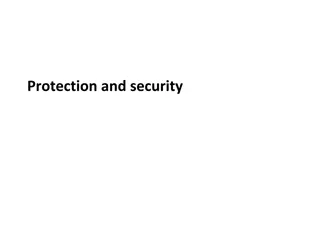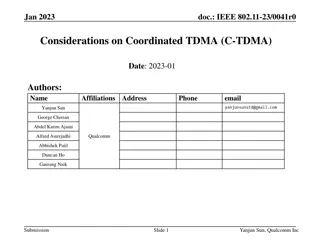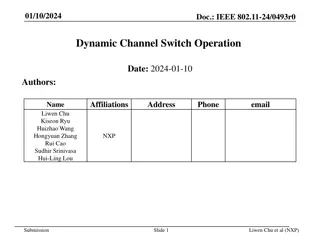NAV protection for C-TDMA
This document discusses NAV protection considerations for fair operation of C-TDMA in IEEE 802.11 networks. It addresses issues related to fairness among neighboring STAs, TXOP sharing, and the impact of hidden STAs on channel access. Various solutions to ensure fair channel utilization and prevent collisions are proposed.
Download Presentation

Please find below an Image/Link to download the presentation.
The content on the website is provided AS IS for your information and personal use only. It may not be sold, licensed, or shared on other websites without obtaining consent from the author.If you encounter any issues during the download, it is possible that the publisher has removed the file from their server.
You are allowed to download the files provided on this website for personal or commercial use, subject to the condition that they are used lawfully. All files are the property of their respective owners.
The content on the website is provided AS IS for your information and personal use only. It may not be sold, licensed, or shared on other websites without obtaining consent from the author.
E N D
Presentation Transcript
February 2024 doc.: IEEE 802.11-24/0375r0 NAV protection for C-TDMA Date: 2024-02-27 Authors: Name Affiliations Address Phone Email Si-Chan Noh sc.noh@newracom.com Newracom Joonsoo Lee js.lee@newracom.com Submission Slide 1 Si-Chan Noh, Newracom
February 2024 doc.: IEEE 802.11-24/0375r0 Introduction The C-TDMA operation is discussed in previous contributions by extending the TXS procedure in 11be [1-3] The proper NAV protection is required to operate C-TDMA [1-4] A shared AP s BSS including legacy STAs to be able to respond downlink and trigger-based uplink transmissions A sharing AP to utilize unpredictable returned TXOP Fairness issues about neighboring STAs during C-TDMA This contribution focus on: NAV protection considering fairness issues among neighboring STAs Return remaining portion of shared AP s TXOP to a sharing AP Submission Slide 2 Si-Chan Noh, Newracom
February 2024 doc.: IEEE 802.11-24/0375r0 NAV protection considering fairness in C-TDMA The C-TDMA allow TXOP sharing between M-APs, we can consider fairness issues of neighboring STAs which are not participated in C-TDMA The NAV protection considering fairness issues of neighboring STAs during C-TDMA procedure can be considered as following : Issue 1: STAs hidden to a shared AP cannot utilize the channel Due to a control frame(e.g., MU-RTS TXS TF) from a sharing AP to a shared AP, EHT STAs which are not participated in C-TDMA cannot transmit any PPDUs Issue 2: If STAs hidden to a shared AP could be offered a chance to utilize the channel, equivalent channel access opportunity could be considered within STAs For example, when HE/EHT STA only overhear a control frame(e.g., MU-RTS TXS TF) in C-TDMA, HE STA may reset its NAV but EHT STA should not reset its NAV after the NAVTimeout has expired One of potential solution for above two fairness issues Adjust NAV duration and/or allocate time in a control frame(e.g., MU-RTS TXS TF) when a sharing AP transmit the control frame to a shared AP It can allow STAs which are hidden to a shared AP to access channel It can allow equal channel access opportunity to neighboring STAs Submission Slide 3 Si-Chan Noh, Newracom
February 2024 doc.: IEEE 802.11-24/0375r0 NAV protection considering fairness and return TXOP in C-TDMA However, contemplating the fairness issues (i.e., previous slide) of STAs which are hidden to a shared AP can affect a sharing AP For example, when a shared AP returns the remaining portion of TXOP to a sharing AP In this case, the sharing AP may not utilize returned TXOP The collision can happen due to the hidden STAs that observe the medium is IDLE after the NAV set duration Submission Slide 4 Si-Chan Noh, Newracom
February 2024 doc.: IEEE 802.11-24/0375r0 NAV protection considering fairness and return TXOP in C-TDMA To provide opportunity to access the channel for neighboring STAs and to allow a sharing AP to utilize returned remaining portion of TXOP from a shared AP, we can consider the following potential solution Potential solution : Fairness aspect Set the duration of a control frame (e.g., MU-RTS TXS TF) not to cover all allocate time To offer neighboring STAs including legacy ones which are hidden to a shared AP to contend channel Allow the sharing AP to utilize returned TXOP The shared AP grants an opportunity to the sharing AP several times It can include an indication of returning TXOP (e.g., preemption enabled (PR) indication) to the sharing AP during its BSS frame exchanges before the end of allocated time The sharing AP can send frame (e.g., preemption traffic indication (PRI)) to the shared AP before resume its frame exchanges or resumes its frame exchanges without sending frame When the shared AP overhears the sharing AP s frame exchanges or receive frame (e.g., PRI) , it may know that the sharing AP will resume its frame exchanges and terminate TXOP Submission Slide 5 Si-Chan Noh, Newracom
February 2024 doc.: IEEE 802.11-24/0375r0 Example of fairness and return TXOP in C-TDMA Scenario : Hidden STAs Shared AP It can access the channel after NAV set duration It can start including indication of returning TXOP during frame exchanges to support last buffered latency sensitive traffic It may have more buffered traffics after transmitting last buffered latency sensitive traffic It can include indication of returning TXOP several times while frame exchanges for buffered traffics until the sharing AP utilize the returned TXOP Sharing AP It can transmit frame (e.g., PRI) optionally before resume its TXOP It can abort TXOP if it cannot recognize the returned TXOP within allocated time Submission Slide 6 Si-Chan Noh, Newracom
February 2024 doc.: IEEE 802.11-24/0375r0 Summary In this contribution, we presented the NAV protection considering fairness among neighboring STAs Moreover, we also presented how to return remaining portion of the shared AP s TXOP with considering fairness issues Submission Slide 7 Si-Chan Noh, Newracom
February 2024 doc.: IEEE 802.11-24/0375r0 Reference [1] 24/1895r2, C-TDMA frame sequence [2] 24/0093r1, NAV setting for Coordinated TDMA [3] 23/1910r1, Coordinated TDMA Procedure [4] 23/1846r1, Protection of Extended TXOP Sharing Submission Slide 8 Si-Chan Noh, Newracom
